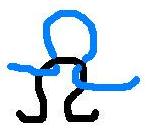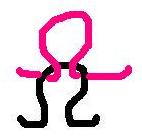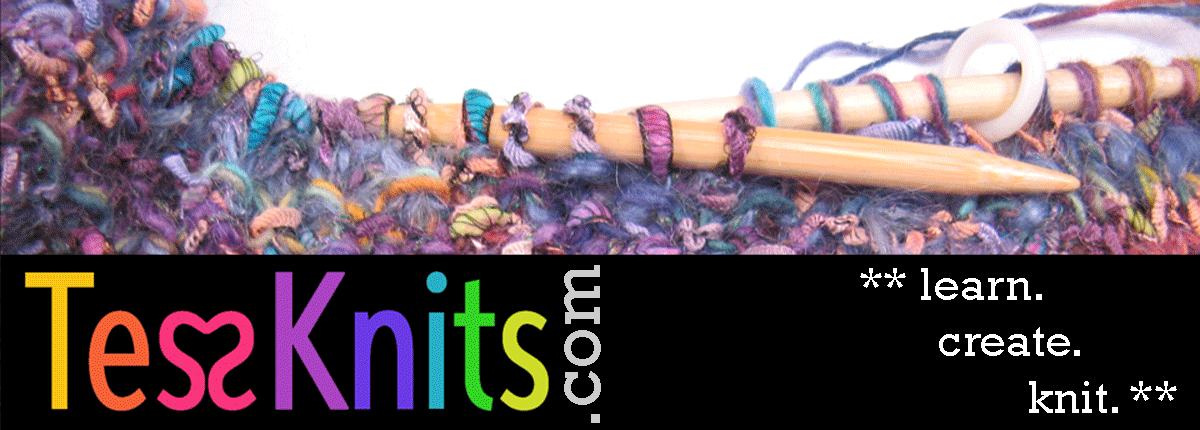Every so often, as I’m teaching a new knitter, the question comes up:
What is the point of purling? Why don’t we just ‘knit’ all the time?
This is actually a really, really good question, if you think about it for a minute. Why DO we bother with purling?
After all, a ‘stitch’ is just a loop pulled through another loop — whether it’s a knit or a purl. So, why bother, indeed? To answer that question properly, let’s take a look at what really distinguishes a knit stitch from a purl stitch. By that I specifically mean, what distinguishes them from each other when they are completed — not what distinguishes them from each other in the way they are performed.
First of all, you have to realize that when we are talking about a completed stitch, the words “knit” and “purl” are used to distinguish between two sides of the same thing — a “stitch”.
It’s exactly like “heads” and “tails” are two sides of the same thing — a “coin”.
If I hold up a coin between you and me, so that I’m looking at “heads”, you would be looking at “tails”. That’s exactly how a stitch is in a piece of knitting. If I look at one side of the fabric, I call it a “knit” — but you, looking at the other side of the fabric, would call the same stitch a “purl”. And we would both be right.
This brings up one fairly important thing that isn’t often spelled out to new knitters: once a stitch is completed, and we are looking at it in the fabric, we always name it as a “knit” or a “purl” according to what it looks like now. That’s why we would both be right in the above example: we would each be naming the stitch according to how it looks to each of us.
Granted, there is some room for confusion in this system — obviously, whether a completed stitch is called a “knit” or a “purl” depends on what side of the fabric you are looking at. However, the alternative would be to go back row by row and stitch by stitch and try to figure out if a stitch was made by physically knitting or purling. That would be exhausting.
So, we end up defining a “right side” and a “wrong side” of the fabric, and go from there. It’s the best system we’ve got, and it’s really not that bad once you get used to it.
But to get back to knits versus purls: the only difference between a completed “knit” stitch and a completed “purl” stitch is
- the knit stitch has the loop of the previous stitch in back of its legs, and
- the purl stitch has the loop of the previous stitch in front of its legs.
(And of course this means that if you flip it over, it looks like the other “kind” of stitch. Just like “heads” and “tails”, remember.)
That’s it. That’s the only difference. Other than that, either “kind” of stitch is just a loop, that has been pulled or pushed through an existing loop. Makes it sound simple, eh?
Here is a stitch.
Sometimes in a class, I will hold up a loop of yarn like this and ask, “Is this a knit stitch or a purl stitch?”
Answer: this is a trick question. We can’t know what kind of stitch this is, unless we know how it is positioned relative to the stitch below it.
The difference between “knit” and “purl” is easiest to understand, I think, if we start with “purl”.

When purling a stitch, the “purl bump” ends up on the side of the fabric that you are currently looking at.

When knitting, the bump ends up on the side of the fabric that you are NOT currently looking at.
Therefore, a purl stitch can be defined as the creation of a bump on the side of the fabric that is facing you.
And, a knit stitch can be defined either as the absence of a bump on the side of the fabric that is facing you — or, the creation of a bump on the side of the fabric that is NOT facing you.
Thus, we knit whenever we want the “bump” (the top of the previous stitch) to show on the side of the fabric that is not facing us.
Conversely, we purl whenever we want the “bump” to show on the side of the fabric that is facing us.
You might think I’m beating this thing to death, if it’s something you already understand well — but I’ve taught many a knitter and believe me, this is not so easy a concept to get across as you might think. It takes some practice to really become fluent with it. It’s worth it, though, because this is the first step in being able to “read” your knitting, and that, my friends, is the true path to knitting enlightenment — to knitting smartly and confidently. Unfortunately, I have yet to find a published book that explains it this way, and yet, I think it’s the only way to really start to understand your knitting.
One more thing is needed for this definition to really work well, and I’ve already touched on it above. We have to think of knitted fabric in terms of having two sides that can be named or distinguished: a right side and a wrong side, or a public side and a private side, or side A and side B, or whatever terms you want to use. Once you have established a RS and a WS, then you can name stitches as knits or purls without confusion. (If it is not stated which side of the fabric is being looked at, you can assume it is meant to be the RS.)
OK, we’ll finish with some examples. Suppose we want to work stockinette stitch. In this case, we want it to be nice and flat on the right side, and we want all the bumps to be on the wrong side.
Therefore, when we are looking at the right side of the fabric, where we do not want to see any bumps, we must knit.
And when we are looking at the wrong side of the fabric, where we want all the bumps to end up, we must purl.
Simple, eh?
What about working stockinette stitch in the round? Well, in that case, we are working around the outside of a tube and we are always looking at the same side of the fabric — we never flip the fabric over. So if we are always looking at the RS, then to get stockinette stitch, we will always be knitting!
In garter stitch, we want to have bumps on both sides of the fabric equally. So we knit a row on the RS, placing all the bumps on the WS. Then we knit a row on the WS, placing all the bumps on the RS. Voila! Garter stitch, with bumps on both sides.
So – what happens if you purl both RS and WS rows?
Well, if we purl a row on the RS, we put all the bumps on the RS. Then we purl a row on the WS, placing all the bumps on the WS. Voila! Garter stitch, with bumps on both sides!
It’s not rocket science, but it is pretty cool.


1 comment for “Why Do We Purl?”